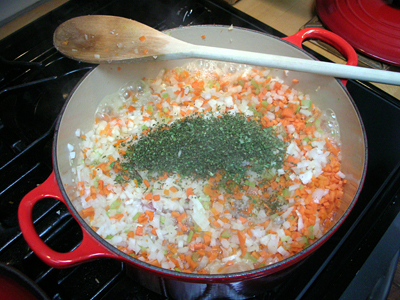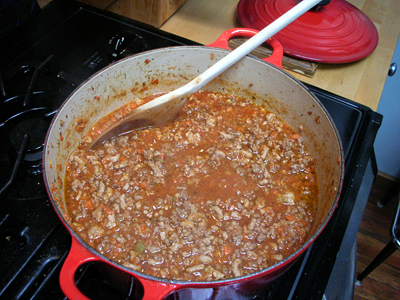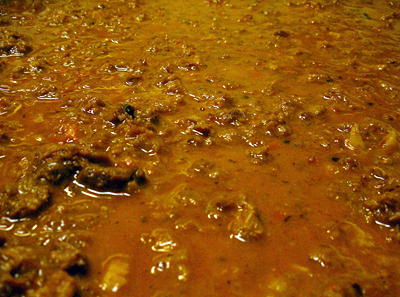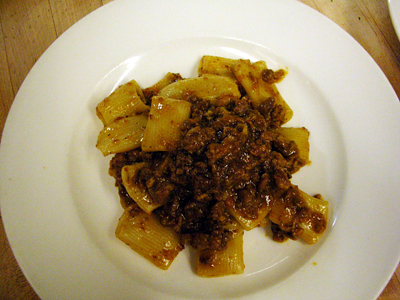
Vegetables sweating on top of meat as the meat brown
At Oliveto, the chefs have reversed the sequence. First they brown the meat and then allow the vegetables to steam, or "sweat," on top of the meat. This process produces a dark layer of caramelized meat solids at the bottom of the pan -- a foundation of flavor. This foundation, or "fond" as the chefs call it, is then deglazed by the natural juices of the vegetables when added on top. This is allowed to cook down so the fond is rebuilt and deglazed two or three times.
Paul Bertolli, the former head chef at Oliveto, describes the technique in his 2003 book, "Cooking By Hand." Bertolli's successor, Paul Canales, who had a role in developing this technique, has continued to refine and perfect it since becoming executive chef.
Cooking a ragu in this manner is not difficult, but it cannot be whipped out in an hour or two. A ragu is truly slow food -- time-tested and refined by Italian grandmothers over many centuries.

Ragu ready for a long simmer, after broth and tomato paste have been added
Ragu for pasta
Makes: 8-10 servings of sauce
Ingredients:
2 pounds ground meat (Beef, pork or equal amounts of both. For beef, try ground chuck or get adventurous with ground hanger steak, beef cheeks, etc. For the pig, try ground pork shoulder.)
4 medium yellow onions
5 stalks celery
5 carrots
4 tablespoons finely chopped fresh sage
2 tablespoons finely chopped fresh oregano
6 cups dark chicken or veal stock
½ cup white wine
½ cup high-quality tomato paste
1 cup cream (optional)
Salt and pepper to taste
Preparation:
1. Dice the onions, celery and carrots into a mirepoix -- cubes smaller than 1/4 inch in size. As you are dicing the vegetables and mincing the fresh herbs, start cooking your meat. Use a heavy bottomed Dutch oven or stew pot. This is essential. The bottom of the pan has to be thick and heavy enough to brown the meat, without scorching it.
2. Use high heat to start your browning process. But keep an eye on it, and adjust the flame accordingly. It’s okay for the meat to stick and brown, but you don't want it to blacken or burn.
3. After you have built an even layer of fond on the bottom, toss your vegetables on top of the meat. Leave them there for at least 15 minutes, allowing them to release their juices to the bottom of the pan.
4. Give your meat and vegetable a rigorous stir with a wooden spoon, and scrape up the fond layer that has now been deglazed by the vegetables.
5. Turn up heat slightly, and allow this to cook down and brown again, then add a shot of wine -- no more than a cup. Stir and scrape.
6. Allow this to cook down again. When browned, add a cup of stock. Repeat the process and add your tomato paste, diluted with a half cup of stock.
7. Watch your ragu carefully at this point. The addition of tomato paste could lead to scorching. Keep the heat up, but stir it regularly as the fond starts to reform. When it is nice and brown, but not scorched, add two or three cups of stock -- enough to make it slightly more soupy than you'd want for a sauce.
8. At this point, your ragu should have a lovely, brownish-red color. Bring it to a boil and then turn down to a simmer. Allow it to simmer for two to four hours, stirring occasionally and adding more stock, if necessary.
9. Before serving, you have the option of adding cream -- as much or as little as you want. Too much cream will dilute the intensity of the sauce, so be judicious at first.
10. You can take this basic sauce in many different directions. Add minced porcini mushrooms early in the cooking for an earthier flavor, or cinnamon or nutmeg to give it a spicy edge. Use different combinations of fresh herbs.
11. The final step, of course, is marrying the ragu with the pasta. Don't just ladle it on top. Cook your pasta just short of al dente, then mix it thoroughly in a skillet with an appropriate amount of sauce and then serve it immediately. Sprinkle some Parmesan cheese on top, and you will be ready to sing.

This is what ragu should look like when finished



